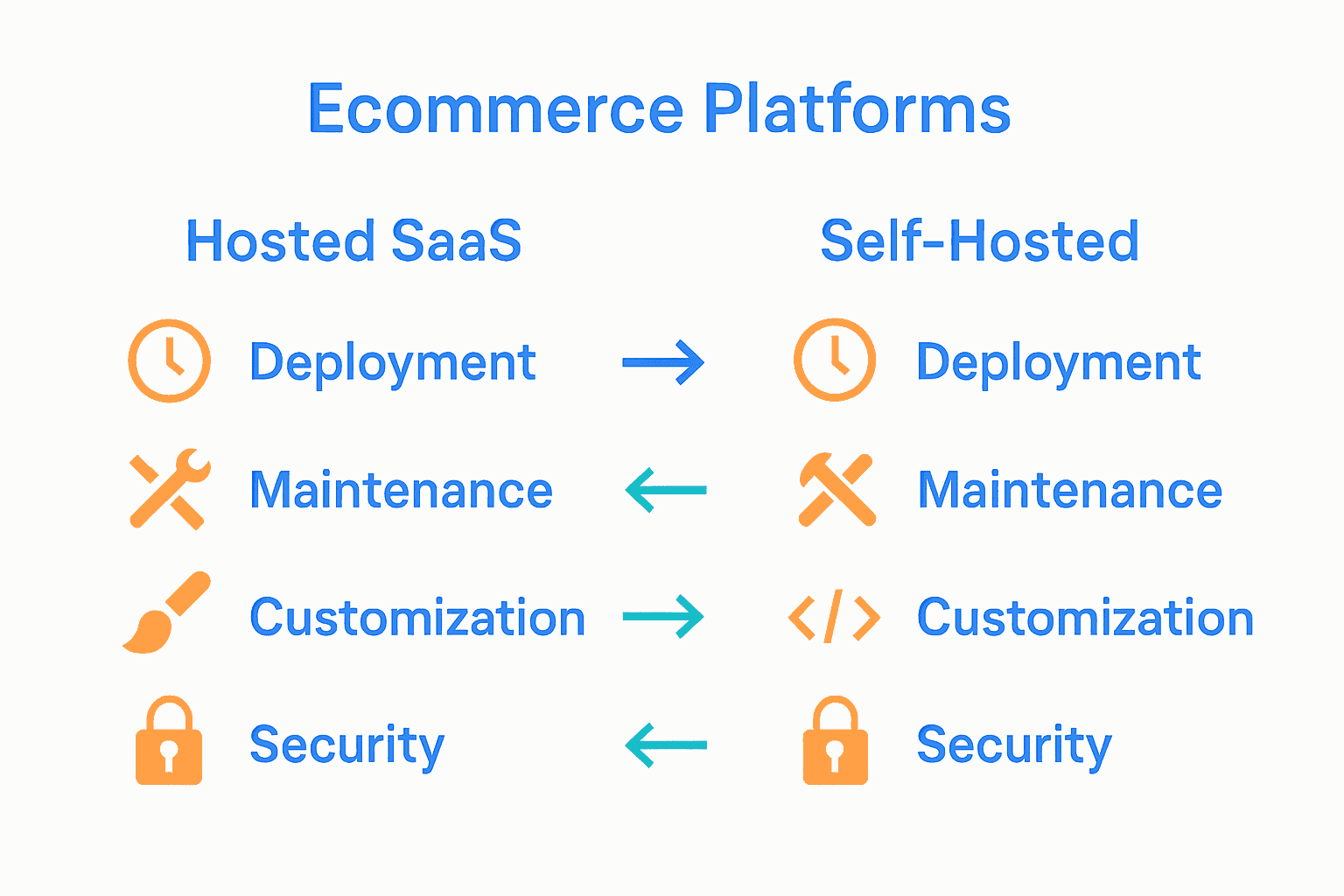Did you know that nearly 21 percent of retail purchases worldwide now happen online? As more customers turn to ecommerce for everyday needs, creating a successful online store is no longer optional. A smooth launch and smart planning can mean the difference between steady growth and missed sales. Start on the right foot by understanding the key steps that set professional ecommerce sites apart from the rest.
Quick Summary
| Key Point | Explanation |
|---|---|
| 1. Clearly define ecommerce goals | Identify your business objectives, target customers, products, and revenue targets to build a strong foundation for your site. |
| 2. Choose the right platform | Select between hosted SaaS and self-hosted solutions based on your technical skills, budget, and business needs. |
| 3. Prioritize storefront design | Focus on creating a user-friendly and visually appealing design to enhance customer engagement and brand representation. |
| 4. Integrate payment and inventory systems | Ensure secure payment processing and real-time inventory tracking for a smooth shopping experience and operational efficiency. |
| 5. Conduct thorough testing before launch | Test for performance and security to build customer trust and prevent technical issues once your site goes live. |
Table of Contents
- Step 1: Define Your Ecommerce Goals And Requirements
- Step 2: Select And Configure Your Platform And Hosting
- Step 3: Design Your Storefront And Implement Branding
- Step 4: Integrate Payment Gateways And Inventory Systems
- Step 5: Test Your Ecommerce Site For Performance And Security
- Step 6: Deploy Your Site And Launch Your Marketing Campaigns
Step 1: Define your ecommerce goals and requirements
Starting an ecommerce site requires strategic planning. You need a clear roadmap that transforms your business vision into a functional online store. This step will help you crystallise exactly what you want to achieve before diving into technical implementation.
Begin by mapping out your fundamental business objectives. Ask yourself critical questions: Who are your target customers? What specific products or services will you sell? What revenue targets do you want to reach within the first year? According to business analysis principles, defining these parameters upfront creates a solid foundation for your digital strategy.
Break down your goals into measurable components. For instance, if you aim to reach small to medium enterprises in South Africa, specify precise metrics like monthly sales volume, average transaction value, and customer acquisition targets. Read more about ecommerce strategy planning to refine your approach.
Consider your platform requirements carefully. As guidance from technology experts indicates, your choice depends on several key factors:
- Business size and current operational scale
- Available budget for digital investment
- Your team’s technical expertise
- Security and compliance needs
- Specific marketing and integration requirements
When determining platform selection, be realistic about your technical capabilities. Not all platforms suit every business model. Some require advanced programming skills while others offer user friendly drag and drop interfaces.
Pro Tip: Document your goals and requirements in a clear spreadsheet. This becomes your project blueprint and helps maintain focus during development.
By the end of this step you will have a comprehensive overview of what your ecommerce site needs to accomplish. Your next phase involves translating these strategic goals into technical specifications and platform selection.
Step 2: Select and configure your platform and hosting
Choosing the right ecommerce platform and hosting solution is a critical decision that will shape your online business infrastructure. This step helps you navigate the complex landscape of digital platforms to find the perfect match for your specific business needs.
Your first major decision involves selecting between two primary platform types. According to industry research, you have hosted Software as a Service (SaaS) platforms like Shopify and self hosted solutions like WooCommerce. SaaS platforms provide an all in package with hosting, security, and automatic updates built in. They are perfect for businesses wanting a quick launch with minimal technical overhead. Learn more about web hosting options to make an informed choice.
Self hosted platforms offer greater customization and control but require more technical expertise. They work best for businesses with dedicated IT resources who want granular control over their online store’s functionality.
When evaluating hosting options, consider these critical factors:
- Website uptime and reliability
- Content Delivery Network (CDN) capabilities
- SSL security certificates
- Payment Card Industry (PCI) compliance
- Scalability potential
- Quality of customer support
For small to medium South African businesses, a managed SaaS platform often provides the most straightforward path. These solutions handle technical complexities while allowing you to focus on growing your business.
Pro Tip: Always test your chosen platform’s performance and compatibility with your specific business requirements before full implementation.
By the end of this step, you will have selected a platform that aligns with your technical capabilities, budget, and growth ambitions.
 Your next phase involves setting up your store’s initial configuration and design.
Your next phase involves setting up your store’s initial configuration and design.
Here’s a comparison of hosted (SaaS) and self-hosted ecommerce platforms:
| Feature | Hosted SaaS Platforms | Self-Hosted Platforms |
|---|---|---|
| Setup Speed | Rapid deployment | Slower, manual installation |
| Maintenance | Automatic updates | Manual updates |
| Customisation | Limited Template based |
Extensive Full code control |
| Technical Skill Needed | Low User-friendly |
High Developer required |
| Security | Included Vendor managed |
DIY Greater responsibility |
| Cost Structure | Subscription fee | Hosting + plugins + development |
| Scalability | Vendor scales automatically | Self managed Resource-based |
Step 3: Design your storefront and implement branding
Your ecommerce storefront is the digital face of your business. This crucial step transforms your brand identity into a compelling online experience that attracts and converts customers across different devices and platforms.
Modern enterprise platforms offer responsive design themes that automatically adjust your storefront’s appearance across smartphones, tablets, and desktop computers. According to platform research, these solutions provide strong SEO capabilities and multi brand management tools that help maintain consistent visual branding.
Start by selecting a theme that reflects your brand personality. Read more about creating powerful visual branding to ensure your online presence stands out. Consider how your color palette, typography, and imagery communicate your business values. Your chosen platform should offer enough customization to make the design feel uniquely yours.
Ensure your storefront design prioritizes user experience. This means creating clear navigation, showcasing products attractively, and making purchase processes smooth and intuitive. Research indicates that responsive and mobile friendly design directly supports brand awareness and customer engagement.
Key design considerations include:
- Consistent color schemes matching your brand
- High quality product images
- Clear and legible typography
- Intuitive menu structures
- Fast loading times
- Mobile responsive layouts
Pro Tip: Your design costs should align directly with your branding goals. Invest in quality visuals that represent your business authentically.
By completing this step, you will have transformed your initial platform into a visually compelling digital storefront that represents your brand. Your next phase involves adding products and configuring your online shop’s core functionality.
Step 4: Integrate payment gateways and inventory systems
Connecting your payment systems and inventory management is a critical step that transforms your ecommerce site from a static storefront to a dynamic business platform. This integration ensures smooth transactions, accurate stock tracking, and a seamless customer experience.
Choosing the right payment gateway represents your first major decision. Look for solutions that support multiple payment methods popular in South Africa such as credit cards, mobile payments, and electronic transfers. Explore secure payment integration strategies to protect your business and customer data.
According to industry research, your payment gateway integration must prioritize several key security considerations. Ensure the system supports PCI DSS compliance, which protects sensitive financial information. Implement tokenization technologies that replace actual credit card details with secure placeholder data during transactions.
Your inventory system should provide real time synchronization across all sales channels. This means when a product sells online, your stock levels automatically update to prevent overselling. Modern platforms offer API connections that link your ecommerce site directly with inventory management software.
Key integration requirements include:
- Secure payment processing
- Real time inventory tracking
- Multi payment method support
- Automated stock level updates
- Fraud prevention mechanisms
- Seamless transaction reporting
Pro Tip: Always test your payment and inventory integrations in a sandbox environment before going live. This helps identify potential technical issues without risking actual transactions.
By completing this step, you establish a robust backend infrastructure that supports efficient business operations.
 Your next phase involves populating your store with products and finalizing configuration details.
Your next phase involves populating your store with products and finalizing configuration details.
Step 5: Test your ecommerce site for performance and security
Before launching your online store, comprehensive testing becomes your critical safety net. This step ensures your ecommerce platform delivers a smooth, secure experience for every customer while protecting your business from potential digital vulnerabilities.
Performance testing starts with evaluating your site’s loading speed and responsiveness. According to hosting experts, reliable platforms should offer high uptime, fast page loading through Content Delivery Networks (CDNs), and robust caching mechanisms. Discover advanced performance monitoring techniques to guarantee optimal site functionality.
Security testing requires a multi layered approach. Research indicates you must validate encryption protocols, implement strict access controls, and ensure PCI DSS compliance. This means checking how your system handles authentication, protects sensitive customer data, and detects potential security breaches.
Your testing checklist should include:
- Page load times across different devices
- Mobile responsiveness
- Secure payment gateway connections
- User authentication processes
- Data encryption standards
- API security validation
- Transaction processing reliability
Pro Tip: Use automated testing tools that simulate high traffic scenarios. This helps identify potential performance bottlenecks before they impact real customers.
By meticulously testing your platform, you create a robust foundation that builds customer trust and prevents potential technical failures. Your final step involves preparing for launch and developing ongoing maintenance strategies.
Step 6: Deploy your site and launch your marketing campaigns
Your ecommerce site is ready to meet the world. This crucial stage transforms your carefully constructed digital platform into an active business engine that attracts and converts customers.
Deployment begins with configuring your marketing tools strategically. According to platform research, your chosen system should support integrated SEO, email automation, social media connections, and abandoned cart recovery mechanisms. Explore powerful digital marketing automation strategies to maximize your launch effectiveness.
Seamless data integration becomes your marketing backbone. This means ensuring your Customer Relationship Management (CRM) system, inventory tracking, and payment platforms communicate smoothly. When these systems work together, you can create targeted marketing campaigns with precision and real time accuracy.
Your marketing launch strategy should include:
- Search engine optimization configuration
- Email marketing automation setup
- Social media integration
- Abandoned cart recovery tools
- Initial promotional campaign designs
- Analytics and tracking implementation
- Customer segmentation strategies
Pro Tip: Prepare multiple marketing channels simultaneously. Do not rely on a single approach but create a comprehensive strategy that reaches customers through diverse touchpoints.
By executing this step, you transform your ecommerce site from a technical project into a living, breathing business platform. Your next phase involves continuous monitoring, optimization, and strategic growth planning.
Take the Stress Out of Launching Your Ecommerce Site
Building your ecommerce presence should be exciting, not overwhelming. If you find yourself worrying about defining your business goals, selecting the right platform, or ensuring seamless payment integration as described in our article, you are not alone. Many South African businesses struggle to move confidently from planning to launch. The truth is, a lack of technical expertise, design alignment, or secure infrastructure can hold your online dreams back. You deserve expert guidance that connects your brand vision to flawless digital execution.
Let Cloud Fusion simplify every stage of your ecommerce journey. Our team brings your goals to life by designing custom stores that match your business requirements, integrating payment and security features, and launching marketing campaigns for impactful results. Ready to see how easy it can be with support from industry leaders? Get your personalised web design and development quote now or learn about web hosting options that keep your site fast and secure. Start the process today at Cloud Fusion. Your future customers are waiting.
Frequently Asked Questions
How do I define my ecommerce goals and requirements?
To define your ecommerce goals and requirements, start by outlining your business objectives, target customers, and product offerings. Create a detailed spreadsheet that documents measurable goals like monthly sales volume and customer acquisition targets to guide your project.
What factors should I consider when selecting an ecommerce platform?
When selecting an ecommerce platform, consider factors like business size, budget, technical expertise, and security needs. Evaluate managed SaaS solutions for quick launches and user-friendly interfaces or self-hosted platforms for greater customization based on your team’s capabilities.
How can I design my ecommerce storefront for optimal user experience?
Design your ecommerce storefront by choosing a responsive theme that aligns with your brand and ensures clear navigation. Focus on creating intuitive menus, high-quality images, and fast loading times to enhance user experience and encourage conversions.
What are the best practices for integrating payment gateways and inventory systems?
Integrate payment gateways that support popular payment methods while ensuring PCI DSS compliance for transaction security. Set up real-time inventory tracking to automate stock level updates and prevent overselling to enhance operational efficiency.
How do I test my ecommerce site before launching it?
Test your ecommerce site by evaluating its loading speed, mobile responsiveness, and security measures. Create a checklist that covers aspects like payment gateway connections and data encryption to identify and resolve issues prior to launching your site.
What steps should I take to launch my ecommerce marketing campaigns effectively?
To launch your ecommerce marketing campaigns, configure your marketing tools to support SEO, email automation, and social media integration. Prepare multiple strategies simultaneously to ensure outreach across diverse channels and enhance customer engagement.








